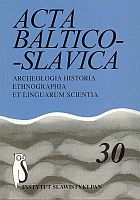Būdvardžių ypatumai Lenkijos lietuvių šnektose
Peculiarities of Adjectives in Lithuanian Local Dialects of Poland
Author(s): Žaneta Markevičiene , Janina MacukonienėSubject(s): Language and Literature Studies
Published by: Instytut Slawistyki Polskiej Akademii Nauk
Keywords: language contacts; adjectives; morphology; Punskas; Seinai
Summary/Abstract: The dialects and subdialects isolated from mainland dialectal areas with national borders always tend to have specific features. They retain diverse lexical and grammatical archaisms and contain interesting innovations typical of their territories. The aforementioned peculiarities are also typical of the Punsk and Sejny local dialects in Poland. They have retained nominal endings of adjectives in more cases than other dialects and have not changed them to pronominal endings (e.g., piktu “angry, dat. sing.”, linksmu “cheerful, dat. sing.”, etc.). They have also better retained some of u-stem adjectival cases (e.g. šaurum “severe, instr. sing.”, smarkus “intense, acc. pl.”, etc.). The most prominent difference between these local dialects and mainland dialects of the Lithuanian language is declension of pronominal adjectives. Thus masculine gender pronominal adjectives of Sejny and Punsk regional dialects acquire the permanent all-paradigm fragment -uj- (e.g., gerujo “the good one, gen. sing.”, gerujam “the good one, dat. sing.”, gerujį “the good one, acc. sing.”, etc.). Such a declension is absent in other Lithuanian dialects. Feminine gender pronominal adjectives mostly gain the permanent all-paradigm fragment -oj- (geroja “the good one, nom. sing. f.”, gerojos “the good one, gen. sing. f.”, gerojai “the good one, dat. sing. f.”). All the eastern and southern dialects of Lithuania have high-level disappearance of the said adjectives. When a paradigm partially disappears and some of the elements are still retained, attempts can be noticed in a language to reconstruct it. Yet, it is usually highly different from its predecessor paradigm.
Journal: Acta Baltico Slavica
- Issue Year: 2006
- Issue No: 30
- Page Range: 533-540
- Page Count: 8
- Language: Lithuanian

